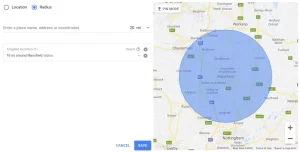5 Things to Know About Google Ads Keywords in 2025
If you want to reach more people on search engines, one method for doing so…
TL;DR – Should You Use Geographic Targeting for Paid Campaigns?
Yes – most businesses can benefit: Geotargeting allows you to serve ads based on location, making them more relevant and cost-effective – ideal for local businesses, expansions, or targeting new markets.
Pros: Greater ad relevance, improved click-through rates, better use of budget, enhanced local engagement, and competitor IP exclusion.
Cons: Requires more setup and attention, risk of mis-targeting, limited views in small areas, and location tracking depends on user consent.
Best for: Local businesses, companies opening new locations, or those targeting regional or international markets with tailored content and offers.
Top tips: Keep targeting tight, craft localised calls to action, support ads with SEO and content marketing, and localise your website for international audiences.
Paid Google ad campaigns are one of the best ways for a business to market its products and services. They’re fast and effective, and it’s possible to zone in on specific audiences with more targeted adverts. Regarding the latter, one method of doing this is by utilising geotargeting.
There’s just one question: Should geographic targeting be part of your paid campaigns, or is this an ad option you should be leaving alone?
Before digesting the meat of this guide, it’s important to first have a clear understanding of geographic targeting – aka geotargeting.
Geotargeting is an option available for Google ad campaigns. If selected, it’s possible to account for the geographical location of your target audience. The location can vary drastically. You might decide to opt for international, national, or local targeted ads. You can even be more specific than that by selecting a specific radius around a location.
To determine the location of a user – and to get your geotargeted ads to the right people – Google utilises numerous signals. However, the search engine king cannot guarantee 100% accurate results. Here’s how they describe it:
Location targeting is based on a variety of signals, including users’ settings, devices, and behaviour on our platform, and is Google’s best effort to serve ads to users who meet your location settings. Because these signals vary, 100% accuracy is not guaranteed in every situation.
As always, you should check your overall performance metrics to help ensure your settings are meeting your advertising goals and change them accordingly.
Also, keep in mind that location options vary on a country-by-country basis. While you don’t have to worry about targeting specific regions, cities, and even postal codes in the UK, your target types can become limited when focusing on international geotargets. You can find out more information about current available geotargets by downloading Google’s official documentation on the subject.
When used correctly, geotargeting can be a fantastic way to optimise the performance of your Google ads. Yet on the other side, it’s not just a land populated by positives. There are also some disadvantages and challenges you need to be aware of before deciding to geotarget your ads.
Are you attempting to grow your brand’s visibility in a specific area? There are numerous reasons why this might be the case. You could run a small local business, be expanding into a new city, or focusing on an entirely new country as part of your international growth. Whatever the reason, geotargeted ads can give your brand a significant – and relatively instant – popularity boost in a new geographic market.
A basic Google ad still has the potential to generate results. Nevertheless, an ad that throws personalised interaction into the recipe is going to serve up a much more irresistible dish for potential customers. Even if it only directly references their location, the message speaks to them and creates a closer connection between them and your business.
Geotargeted-based marketing opens the door to a wide range of metrics you can use to benefit your business. As geotargeting is based around smartphone use, it’s possible to gain ample data about how your audience uses this platform to interact with your brand.
When done right, geotargeted ads will boost the click-through rate when matched against standard ad campaigns. The reason for this is simple: the ads are targeted. By targeting specific users, rather than opting to use wide-sweeping, generic ads, this will resonate better with your target audience – and subsequently enhance your long-term results.
One of geotargeting’s most unique advantages is the ability to place your ads out of view from the competition. This can be achieved by adding IP exclusion into the mix, finding the IP of your competitors, and excluding them from your campaigns. This is recommended if you are testing a new ad strategy or offer, as it will stop your competitors from knowing what you’re up to.
 Added time and resources are required:
Added time and resources are required:Forget about attempting to recycle your previous ad campaigns. As the focus is on a specific location, your ad content must be tailored for this location – otherwise, the entire campaign could fall flat. This requires more time and resources than simply launching another standard ad campaign.
 Mistakes can be made:
Mistakes can be made:A lot of careful planning is needed when putting together a geotargeting ad campaign. All it takes is one simple mistake for your ads to end up in completely the wrong location, wasting your marketing budget in the process. For instance, say you want to target potential customers in Newcastle. If you’re not too observant, instead of your ads being sent to North East England’s most popular city, they could go to those in Newcastle, New South Wales, Australia!
 Certain locations not available:
Certain locations not available:Admittedly, this shouldn’t become a concern if your potential customers are based in locations across the UK or US or if you’re targeting large areas like cities and postcodes. Yet it is still important to remember that certain specific locations remain unavailable with geotargeting Google ads.
 Customer activation is required:
Customer activation is required:It’s not guaranteed that you can reach every viable user within a specific geotarget. This is because customers have to approve tracking of their location. If they do not agree to this, then Google cannot give them personalised ads based on their location, and your own ads won’t be seen by these users. The disabling of location tracking can scupper optimal performance for your ad campaign.
 A limit to views and interaction:
A limit to views and interaction:When you target a smaller market, this will put a limit on ad views and interaction. As with any paid campaign, your ads won’t magically appear for everyone within the geographic location you’re targeting. Users have to go on the right website or app for them to pop up. With fewer people seeing your ads on average, it will take longer for your campaign to hit the numbers you’re anticipating.
Certain businesses won’t particularly benefit from geotargeting. Think about online businesses that are not defined by their location. If there’s no interest or reason to grow in a specific geographical market, it obviously doesn’t make sense to add this parameter to your Google ad campaigns.
However, there are many businesses – both big and small – that can reap the benefits of geotargeted ads.
It’s especially advantageous for local brick-and-mortar businesses. Restaurants, independent shops, accountants – these types of local establishments can all use geotargeting to their advantage. This is particularly the situation if their customers are exclusively local. After all, why would a small eatery want to advertise to people on the other side of the country?
With geotargeted ads, they don’t have to worry about their ads being displayed to the wrong people. It’s possible for them to stick to the town or city their local business is based in, ensuring only those who’d actually be in a position to make the trip to their establishment are targeted.
It’s obvious how geotargeting can help a small, local business, but it is also beneficial for larger organisations.
As mentioned already, geotargeting isn’t necessarily just for local markets. You can expand into regional, national, and international markets with this ad type. This is useful when your business is experiencing a major expansion and you need to quickly build your presence in new areas.
Even if your business isn’t rapidly growing, geotargeting can be a useful tool to have in your marketing repertoire. Say you’re opening a new store in a different city. With this ad type, you have the ability to focus on this new market, attract the attention of potential customers, and improve both the short and long-term success of your additional store.
To make the most of your geotargeting, it’s imperative you know how to use it effectively for your ad campaigns. Here are a few tips to keep in mind:
Okay, you might want to target an entirely new country – and in some cases, this is fine – but it’s advised you limit your scope. This is how to optimise the location of paid search ads. By sticking to a smaller geographical location, it’s possible to maximise the relevancy of your ad content.

Every paid ad should incorporate an effective, clear call to action. That’s obvious. Yet with geotargeting, it’s possible to craft a call to action that is even more impactful – and gets your target audience clicking with greater urgency.
For instance, you can incorporate local information into your call to action. By combining this information with your latest discount or deal, it’s more likely to motivate them into moving forward with a purchase from your business.

A successful marketing campaign isn’t built with just a single marketing tactic. It needs to feature an assortment of other strategies that all intertwine with each other. Your geotargeting ads should be joined by the likes of content marketing, search engine optimisation (SEO), social media, remarketing, and so on.
Your geotargeted ads might be super specific and optimised, but this often isn’t enough to get that all-important conversionA conversion is a desirable result on a website that leads to an action such as completing an order, filling out a form, or simply clicking on a link. over the line. In general, you have to market to potential customers multiple times before they bite. This is achieved with a cohesive, unified marketing campaign that supplies a seamless purchasing journey for the customer.
If it’s a new international market you want to reach with your geotargeting attempts, prepare to put in additional work to see the conversions you expect. The ad might have caught their attention, but it’s up to your website’s content to seal the deal.
With this in mind, here are a few points to remember when modifying your website for international geotargeted audiences:
Now let’s go back to the question posed at the top of this page: should you use geographic targeting for paid campaigns?
In general, the answer is a resounding ‘Yes.’ There are certain businesses where geotargeting makes no sense. Plus, as mentioned above, there are various disadvantages to consider when going down this route with your Google ads.
However, geotargeting is a fantastic way to zone in on a specific market, delivering them with personalised, tailored ads that have a greater chance of success than those bog standard, generic ads. This increases interest in your business, improves click-through rates, opens the door to more conversions, and maximises your marketing budget – it’s a win-win all round.
If Google's latest Web Core Vitals update has caused havoc to your SEO results, find your solution in our latest in-depth ebook.
There’s a good chance that you’ve already heard of PPC. As a marketing tool, PPC is invaluable, but there seems…
What is Content Marketing? Download Our How-To Guide Today!